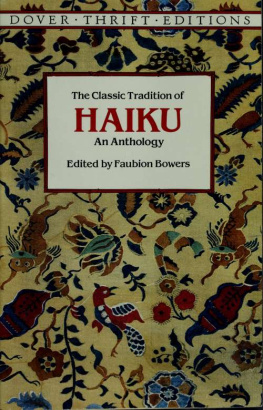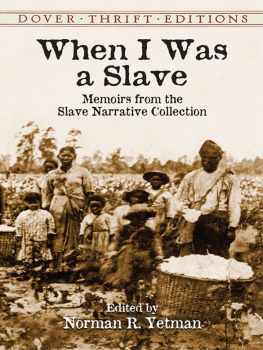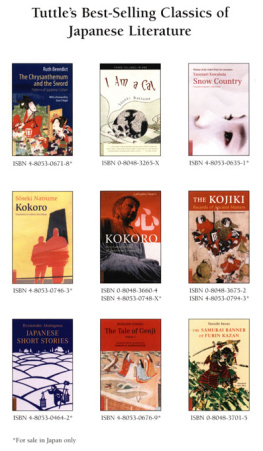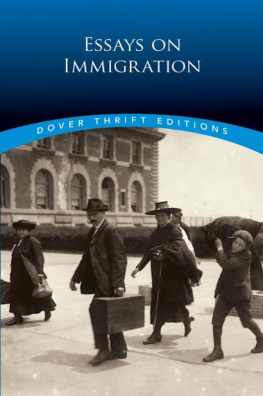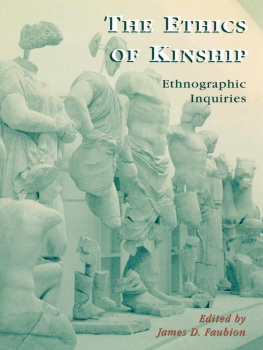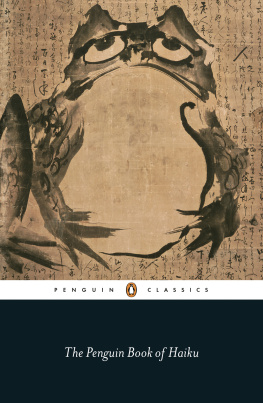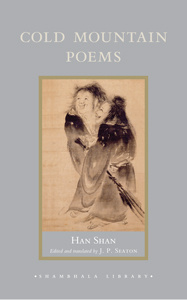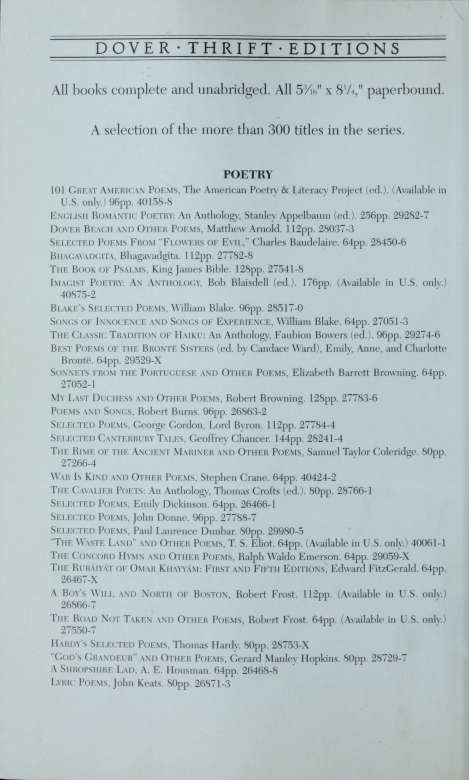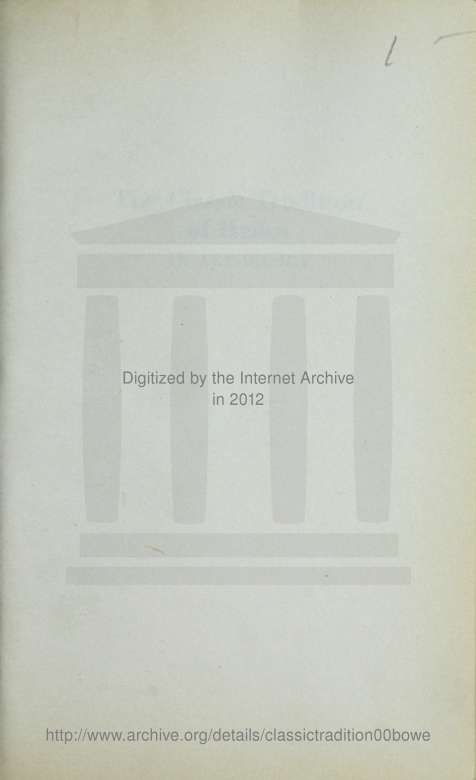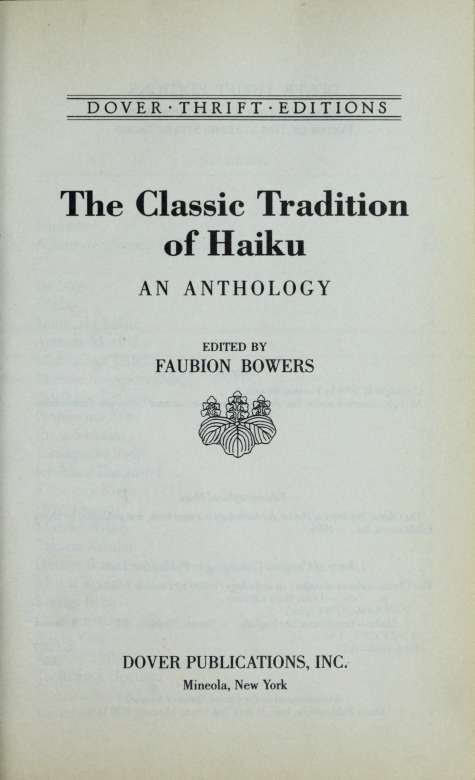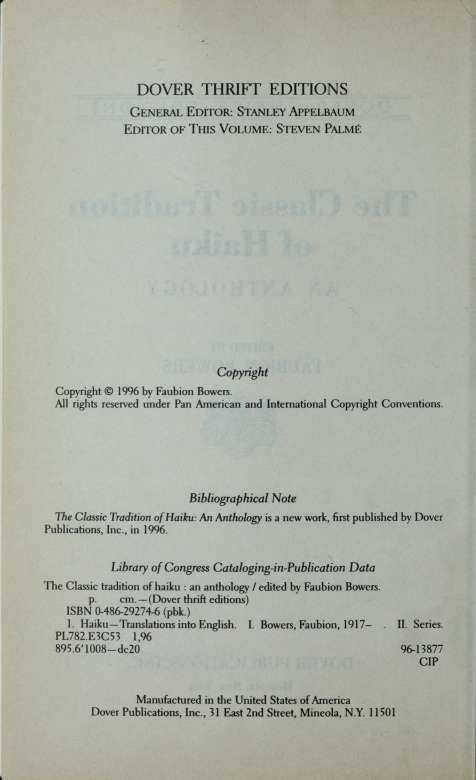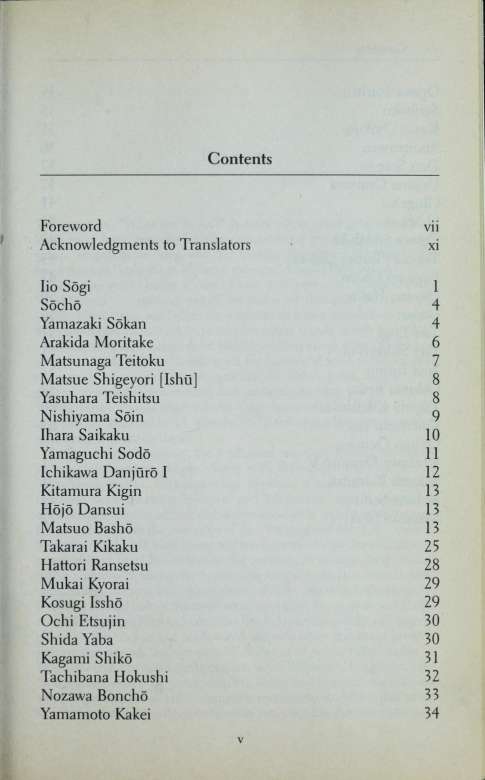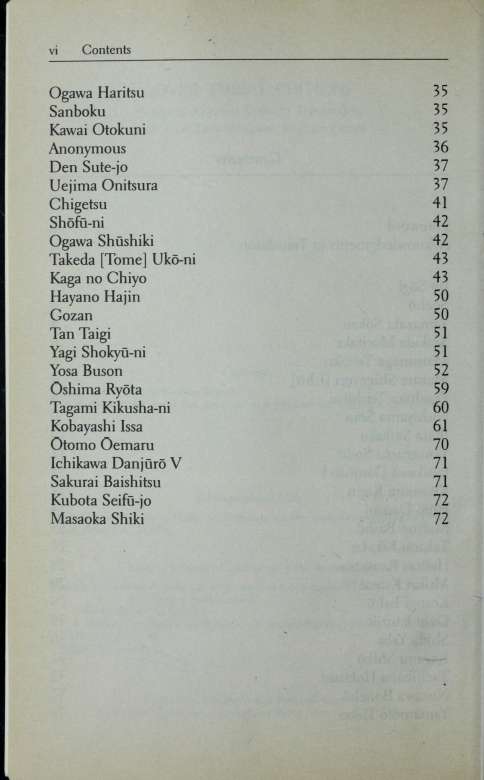This book made available by the Internet Archive.
viii Foreword tury. Hai in haikai means "unusual" and ku denotes strophe, lines, stanza or verse. Recently, hokku and haiku have become interchangeable. The Haiku Society of America, founded in 1968, spent two years and used some 200,000 words in letter exchanges among authorities before reaching a dictionary definition for haiku. They are the world's shortest poems, consisting of 17 syllables arranged in a sequence of 5-7-5.
An example, written in English by the poet James Kirkup, demonstrates the 5-7-5 syllabic pattern: Haiku should be just small stones dropping down a well with a small splash In Japanese, haiku comprise as few as three or, at most, ten words, but translation into English often requires many more. The Japanese language has 50 sounds: 5 short and long vowels (long vowels count as two syllables* in haiku) that can combine with 14 consonants. By contrast, English has 20 consonants that combine with 6 vowels. All Japanese words end in a vowel, except for a few ending in a slightly nasal "n" (counted as one independent syllable). Rhythmically, Japanese falls into measures of five and seven syllables. These single word- or phrase-lengths flow as naturally as iambs or trochees do in our more strongly accented English.
Novels, Kabuki dramas and thousand-stanza poems have been written in the alternating 5-7 (or 7-5) syllabic system. There is much discussion but little agreement among scholars as to whether haiku should be transcribed in one, two or three lines. In Japan haiku are usually printed in one vertical column but, when handwritten on poem cards, they often appear in three columns, making visible the 5-7-5 syllabic impulse. Arthur Waley (1865-1966), an early translator of Japanese literature, , wrote, "It is not possible that the rest of the world will ever realize the importance of Japanese poetry, because of all poetries it is the most completely untranslatable." To our way of thinking, Japanese poetry lacks sentence structure. It is imprecise in articles, particles, plurals and gender, and uses neither capital letters nor punctuation. Rhyme is easy and monotonous and, therefore, something to be avoided.
Japanese, even with its limited number of basic sounds does, however, lend itself to an abundance of wordplays double entendre, puns, assonances, alliterations, frontal rhymes and onomatopoeia. In all their brevity, haiku do tell a story and paint a vivid picture, leaving it up to the reader or listener to draw the meanings out and Foreword ix complete them in the mind's eye. Many poets embellished their writing with shorthand, brush-stroke drawings. Each haiku also contains a hidden dualism: the near and the far, foreground and background, then and now, past and present, high and low, sound and silence, and temporality and eternity. Haiku lovers look for specific words and images to help reveal the deeper layers of meaning that expand the scope of each poem. These fall into three general categories: What, Where and When.
The "what" is the poet's reaction to something affecting one or more of the senses: sight (swirling petals or falling leaves); hearing (the sound of a waterfall or the tumble of a scarecrow after the harvest); scent (the faint aroma of plum blossoms or of a wilted chrysanthemum); and even taste (the tang of a persimmon or the delicate freshness of the season's first eggplant). The "where" can be a particular place redolent with connotations and associations such as the ancient capital of Nara, Mt. Fuji or the exile island of Sado. "Where" can also be as vague as an unnamed pond, a road or an inn. The most evocative part of haiku is "when." Many haiku presuppose a time of year, month or day. The place in time of the poem is often conveyed by references to occurrences in nature or to specific flora and fauna.
Haze connotes spring; clouds, summer; mist or fog, autumn. A frog denotes late spring; plum is the first flower of the New Year; wisteria blooms in late spring and morning glories in summer. Whether or not one knows the language, haiku cannot be truly appreciated without some attention to the original sounds. It is useful to note the kireji (cutting word), meaningless syllables such as ya, kana, zo, yo, or keri. Although haiku are "songs" to be uttered in one breath, the cutting word introduces a minute caesura or thought-pause for emphasis. In Japanese it occurs often on the fifth or twelfth syllable, and breaks the tiny poem asymmetrically.
In English, translators convey the idea by punctuation marks (!, ,..., and :) or by expressions such as "Ah," "Lo" or "Behold." There are an estimated one million haiku writers in Japan today. Most newspapers run haiku sections to which subscribers submit poems for comment. Scholars deliver hour-long lectures on the meanings of just one of these 17-syllable poems. Stones with haiku carved in them dot the cities and countryside and commemorate places where laureates, past and present, have paused during long journeys seeking poetic inspiration from the landscape. In no other country is poetry more deeply respected, or so pleasantly ubiquitous. Acknowledgments to Translators Each translation in this anthology is followed by the initials of the translator.
The following list, arranged in alphabetical order by initials, identifies each translator and, when applicable, the work from which his translations were taken. AG Allen Ginsberg. Collected Poems J 947-J 980. New York: Harper-Collins, 1984. AK Alex Kerr. Lost Japan.
Melbourne, Australia: Lonely Planet Publishers, 1996. AM Asataro Miyamori (1869-1952). One Thousand Haiku: Ancient and Modem. Tokyo: Dobunsha, 1930. BHC Basil Hall Chamberlain (1850-1935). 2, no. 30 (1902). 30 (1902).
BLE Bernard Lionel Einbond, Professor of English Literature at Lehman College, City University of New York. BW Burton Watson, former Professor of Japanese and Chinese at Columbia University. From the Country of Eight Islands, by Hiroaki Sato and Burton Watson. New York: Doubleday, 1981. CAC Cheryl A. "Putting Makoto into Practice: Onitsura's Hitorigoto" Monumenta Nipponica, vol. 50, no. 1 (1995). 1 (1995).
CHP Curtis Hidden Page (1870-1946). Japanese Poetry. Boston: Houghton Mifflin, 1923. CMW Clara M. Walsh. Master Singers of Japan.
London: John Murray, 1910. DF Dallas Finn. Meiji Revisited: The Sites of Victorian Japan. Trumbull, CT and New York: Weatherhill, 1995. DK Donald Keene, Professor Emeritus of Japanese at Columbia University. Landscapes and Portraits.

